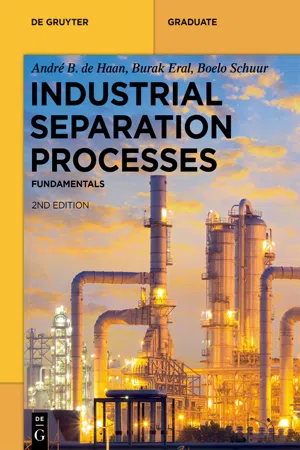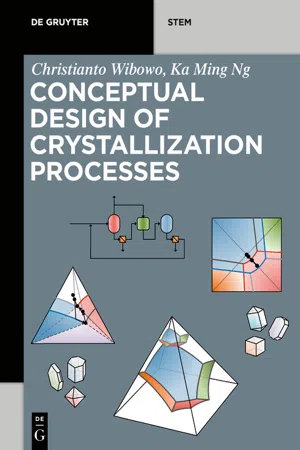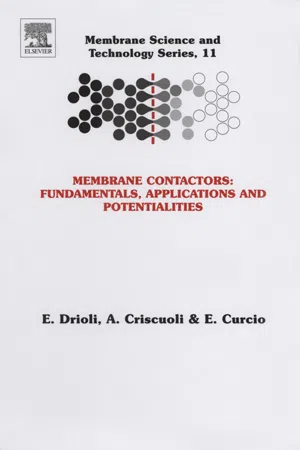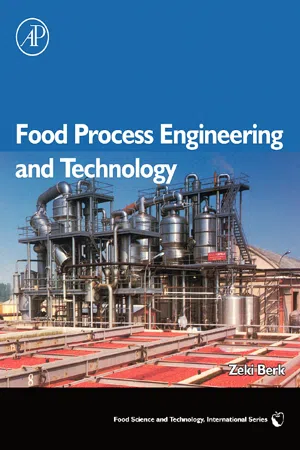Technology & Engineering
Recrystallization
Recrystallization is a process used to purify solid compounds by dissolving them in a hot solvent and then allowing the solution to cool, causing the compound to crystallize out in a purer form. This technique is commonly employed in the chemical industry to separate and purify substances, particularly in the production of pharmaceuticals and fine chemicals.
Written by Perlego with AI-assistance
Related key terms
Related key terms
1 of 4
Related key terms
1 of 3
5 Key excerpts on "Recrystallization"
- eBook - ePub
Industrial Separation Processes
Fundamentals
- André B. de Haan, H. Burak Eral, Boelo Schuur(Authors)
- 2020(Publication Date)
- De Gruyter(Publisher)
Figure 8.1 . The crystals separated from the solvent can be washed and dried depending on the product specifications. Large quantities of crystalline products are manufactured commercially such as table salt (sodium chloride), industrial salts (electrolysis brine), sucrose, battery materials (lithium salts), commercial polymers (poly(lactic acid), poly(vinyl acid)) and fertilizer chemicals (ammonium nitrate, ammonium phosphates, urea). In the production of organic chemicals such as pharmaceuticals, fine chemicals and polymers, crystallization is used to recover product, to refine intermediate chemicals and to remove undesired salts. Crystalline products coming from the pharmaceutical, fine chemical and dye industries are produced in relatively small quantities but represent a valuable and important industrial sector. Beyond the applications focused on manufacturing fine chemicals, crystallization is also used to separate and purify as in desalinization and water reuse.Figure 8.1: Schematic of a crystallization process followed by solids processing sequence.Crystallization achieves separation through liquid-to-solid phase transition. Once crystallization occurs, solute molecules dissolved in solvent form a solid crystalline phase. Analogous to distillation or extraction, the new crystalline phase created from solution contains concentrated solutes. A unique feature of crystallization is that extremely high purities (>99% even 99.9%) can be achieved as in the crystalline phase. In melt crystallization, only one chemical species is considered, for instance, crystallization of a urea melt into urea crystals. In a solution crystallization process, the feed consists of a homogeneous solution of different chemical species, namely, dissolved solute and solvent. Impurities, that is, foreign substances different from solute or solvent, are always present in both melt and solution crystallization. In order to crystallize a solute, supersaturation in the mother phase (either solution or melt) is needed. A supersaturated solution carries more solute than the thermodynamic equilibrium value. Supersaturation is created either by cooling, evaporation of the solvent or addition of an anti-solvent to obtain the desired solute in a solid form. It is also possible to utilize these methods in tandem. The process of solid phase formation is termed as crystallization, and the operation occurs in a vessel called a crystallizer as shown in Figure 8.1 . Crystallization consists of two fundamental phenomena, nucleation and growth (Figure 8.2). In nucleation, solute molecules dissolved in solvent come together and form the first-ordered solid structures called nuclei. The nucleation event involving only the solute molecules is called homogeneous nucleation (Figure 8.2 ). If the nucleation starts on the surface of a foreign object such as impurities or crystallizer walls, this is referred as heterogeneous nucleation. In addition to homogeneous and heterogeneous nucleation, a nucleation phenomenon with strong influence on crystal quality is secondary nucleation. In secondary nucleation, pieces of previously “chipped off” crystals are formed due to collisions of already nucleated crystals with the impeller, crystallizer walls or collisions between crystals. The chipped off crystals act as heteronucleants encouraging nucleation of dissolved solute on their surface (Figure 8.2 ). After nucleation, the nuclei grow by addition of more solute to existing nuclei and become larger until they are removed (harvested) from the crystallizer. Growing crystals can simultaneously go through aggregation and attrition as they grow to their final size. The performance of a crystallization process is also characterized by crystal quality parameters, crystal morphology, size distribution, polymorphism and purity. Consistently producing crystalline products with desired crystal quality parameters is essential in industrial practice. The aforementioned crystal quality parameters are also referred as four pillars of crystallization. These solid phase properties are especially important because crystallization is frequently the initial step in further solid processing sequence such as filtration, similar to that shown in Figure 8.1 - eBook - ePub
- Christianto Wibowo, Ka Ming Ng(Authors)
- 2020(Publication Date)
- De Gruyter(Publisher)
1 Introduction1.1 Crystallization in the Chemical Processing Industries
Crystallization is an important separation technique in the chemical processing industries for various reasons. First, it is able to produce a high-purity final product in solid form. Most separation techniques such as extraction and absorption simply transfer the chemical product from one phase to another. Second, crystallization can be scaled up for large-scale production while techniques such as electrophoresis and chromatography are only suitable for the separation of chemicals in small quantity. Third, it can separate organics, biochemicals, inorganics, and polymers that are sensitive to heat or have high boiling point. This is important, as chemical companies, in search of a higher profit margin, shift their focus from commodity to specialty chemicals that often cannot be separated by distillation. Fourth, like distillation, crystallization allows the complete separation of a multicomponent mixture of chemicals even if the system exhibits complex phase behavior. In distillation, this is achieved by bypassing the azeotropes using extractive distillation, azeotropic distillation, and so on. In crystallization, this is accomplished by bypassing the eutectics using fractional crystallization, extractive crystallization, and so on.Table 1.1 lists a number of examples that illustrate the wide range of applications of crystallization in the chemical processing industries. The earliest applications of crystallization mostly deal with the recovery of inorganic salts from solution by evaporating water. The harvesting of salt from seawater has been practiced since antiquity [1 ]. Similarly, the separation of potash as a fertilizer from sodium chloride has been a major industrial operation to this day. Lithium carbonate, the major component for lithium batteries, is extracted from salt mines via crystallization from brines. Recently, there is a significant increase in the co-precipitation of compound salts such as Ni0.6 Co0.2 Mn0.2 (OH)2 to meet the rising demand for cathode materials used in electric vehicle batteries. Crystallization is also widely used in the production of organic commodity chemicals such as p-xylene, bisphenol-A, terephthalic acid, and adipic acid, to separate the desired product from impurities and byproducts. Many specialty chemical and pharmaceutical products, such as diamondoids, azo dyes, monosodium glutamate, vitamin C, aspirin, and ibuprofen, are isolated in solid form by crystallization. In fact, most small molecule drugs (>90%) are delivered in crystalline form, and about 90% of newly developed active pharmaceutical ingredients are sparingly soluble in water [2 - Enrico Drioli, A. Criscuoli, E. Curcio(Authors)
- 2011(Publication Date)
- Elsevier Science(Publisher)
Chapter 7Membrane Crystallization
1 Introduction to crystallization from solution
Crystallization is an excellent technique for purification of chemical species by solidification from liquid mixtures: many materials are marketed in crystalline form, and a large amount of product may be obtained from impure solutions even in a single step. The attraction for this method is heightened when considering that crystallization may operate at lower temperatures and requires lower energy than other conventional separation processes [1 ]. In 1999, the world production of crystals limited to use in electronic industry has been estimated at more than 20,000 tons per year, of which the largest fraction are semiconductors silicon, GaAs, InP, GaP, CdTe and its alloys, scintillation and optical crystals [2 ]. Crystallization technology also provides powerful aids in the manufacture of pharmaceutical compounds, with particular interest in chiral discrimination and polymorphism [3 ]. In biochemistry, the detailed description of protein structure at the atomic level is achieved by X-ray diffraction analysis as applied to single crystals [4 ]. In general, the particle size distribution and morphologies produced are a result of the relative rates of nucleation and growth of crystals from a supersaturated solution. Supersaturation may be created in a number of ways: by cooling or heating (if solubility decreases with temperature) a saturated solution, by evaporating the solvent, by addition of another component to the reaction environment thus reducing the solubility of the solute, by salting out, by reaction to form the solute in situ etc. When a substance is transformed from phase 1 to phase 2, the change in molar Gibbs free energy (Δ- eBook - ePub
Solid–Liquid Separation Technologies
Applications for Produced Water
- Olayinka I. Ogunsola, Isaac K. Gamwo, Olayinka I. Ogunsola, Isaac K. Gamwo(Authors)
- 2022(Publication Date)
- CRC Press(Publisher)
2 Therefore, it can surely be considered as one of the oldest separation technologies in chemical engineering. It represents the workhorse for separation tasks because it is often the most robust and cost-effective unit operation. Crystallization may be defined as a phase change in which a solid (crystalline) phase is generated from a liquid. This liquid feed can be either a solution composed of at least two or more solutes (species) in a solvent forming a homogeneous mixture or a melt that most correctly refers to a pure solid, molten above normal conditions. However, melts may be also homogeneous mixtures of more than one compound.The purpose of this chapter is to provide the basic concepts that govern crystallization processes and discuss the practical aspects of conventional processes (Section 9.5 ) and latest technical advances (Section 9.6 ) related to the application of crystallization as a separation technology for produced waters. Particularly, the technologies described in Section 9.6 are aimed at near zero waste discharge by simultaneous recovery of water and the dissolved compounds as valuable products. Therefore, a brief understanding of the crystallization concepts is needed and will be discussed first. For the interested reader, detailed information can be found in specialist literature on industrial crystallization,2 ,3 and 4 process monitoring and control5 ,6 as well as in the various literature cited within this chapter.9.2 Basic Crystallization Concepts
9.2.1 Solid –Liquid Equilibrium and Solubility
The knowledge about the equilibrium between a solid and a liquid phase is the thermodynamic foundation needed to develop, design, and control crystallization processes whether conducted from solution or melt. A phase diagram graphically displays this equilibrium between all possible thermodynamic states of a system (defined by temperature T, pressure p, composition c). In most systems, the effect of pressure on solid–liquid equilibria is negligible. Therefore, phase diagrams are typically plotted as composition versus temperature at constant pressure (Figure 9.1 - eBook - ePub
- Zeki Berk(Author)
- 2008(Publication Date)
- Academic Press(Publisher)
Chapter 14. Crystallization and Dissolution
14.1. Introduction
Crystallization (Mersmann, 1995 ; Hartel, 2001 ; Decloux, 2002 ) is the process by which solid crystals of a solute are formed from a solution. The liquid phase remaining after the formation of the crystals is called ‘mother liquor’. In the food industry, crystallization may serve for the recovery of crystalline products (sugar, glucose, lactose, citric acid, salt), for the removal of certain undesirable components (winterizing of edible oils, a process consisting of chilling certain oils in order to solidify and remove waxes and other high melting-point components) or for the modification of certain food products in order to obtain a desirable structure (crystallization of sugar in the production of fondant and marzipan in confectionery, crystallization of fat in chocolate and margarine, candying of fruit). In foods, crystallization may also be an undesirable change which must be avoided. Typical examples are the crystallization of sugar in jams and preserves, the crystallization of lactose in ice cream, which is the cause of a defect known as ‘sandiness’ and the Recrystallization of cocoa butter in chocolate in the form of white crystals (bloom) on the surface of the product. Processes based on the crystallization of water to form ice crystals (freezing, freeze drying, freeze concentration) are discussed elsewhere in the book.Crystallization can occur only in supersaturated solutions. A solution can be brought to supersaturation
Index pages curate the most relevant extracts from our library of academic textbooks. They’ve been created using an in-house natural language model (NLM), each adding context and meaning to key research topics.
Explore more topic indexes
Explore more topic indexes
1 of 6
Explore more topic indexes
1 of 4




